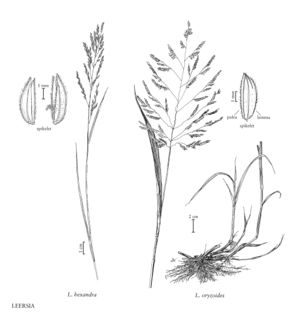Leersia oryzoides
Plants perennial; rhizomatous, rhizomes elongate, scaly, scales not imbricate. Culms 35-150 cm tall, 1-3 mm thick, branching, decumbent, sprawling, rooting at the nodes, terminal portions erect. Sheaths scabrous; ligules 0.5-1 mm; blades 7-30 cm long, 5-15 mm wide, spreading to slightly ascending, both surfaces usually scabrous. Panicles 10-30 cm, terminal, also axillary, exserted or enclosed at maturity, spreading on exserted panicles, usually 2 or more branches at the lowest nodes, 1 at the upper nodes; branches 4-10 cm, the lower 1/3 naked, spikelets imbricate. Spikelets (4)4.2-6.5 mm long, 1.3-1.7 mm wide, elliptic. Lemmas and paleas usually ciliate on the keels and margins, glabrous or puberulent elsewhere; anthers 3, 1.5-2(3) mm in chasmogamous spikelets, 0.4-0.7 mm in cleistogamous spikelets. Caryopses 2-3.5 mm, asymmetrically pyriform to obovoid, whitish to dark brown. 2n = 48.
Distribution
Conn., N.J., N.Y., Wash., Del., D.C., Wis., W.Va., Md., Fla., Wyo., N.H., N.Mex., Tex., La., Tenn., N.C., S.C., Pa., Nev., Mass., Maine, R.I., Vt., Va., Colo., Calif., Ala., Kans., N.Dak., Nebr., Okla., S.Dak., Ark., Ill., Ga., Ind., Iowa, Ariz., Idaho, Ohio, Utah, Mo., Minn., Mich., Mont., Miss., Ky., Oreg., B.C., Man., N.B., N.S., Ont., P.E.I., Que., Sask.
Discussion
Leersia oryzoides grows in wet, heavy, clay or sandy soils, and is often aquatic. It is found across most of southern Canada, extending south throughout the contiguous United States into northern Mexico, and flowers from July to October. It has also become established in Europe and Asia.
Selected References
None.
